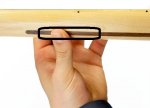A pick hand laceration (thumb nerve damage) interrupted playing (guitar only) for a prolonged period--just starting back.
It occurred to me that during the timeframe of developing calluses again it seems a period prone to developing bad habits fretting. Therefore, keeping it basic and repetitious seems practical to avoid this as well as stopping playing once sensitivity impairs fretting even slightly.
Until I have calluses again well developed, I've been playing only slight variations on a G-C-D cross-picking/strumming exercise (Blue Grass genre)--good for pick accuracy, too, if you're familiar with cross-picking. Whatever warm up exercises you use for your playing might be workable--something familiar--though I am personally avoiding slides and bends until I am confident I will not be falling into incorrect technique.
(I've noticed a lot about subtle dynamics during this period playing the same exercise each day, so better listening to my playing has developed during this repetitious playing but needs to be intentional in listening.)
Of question for members, as we humans move past middle age the skin gets thinner. I've notice, from time to time, minor tears (not cuts) on the skin and have no idea of how I caused them, like during gardening. Are any of my peers (on this thread) in this age group; if so, is fretting more difficult in developing calluses because of thinning skin? (The skin on the tips of fingers seems more durable--maybe thicker--than on the back of the wrist.) Is it a matter of patience?
For the last 2 weeks, I've been playing for about 20 minutes a day or until my fretting begins to get sloppy in placement or holding down strings difficult due to sensitivity. (If I over do it, I let the sensitivity subside for a couple of days rather than have my fingers tend to avoid tender areas--this is what I meant, in part, by developing poor habits. Indentations on the tips where they normally wouldn't be is proof of this tendency if playing through too much sensitivity.)
I hope this helps others avoid falling into bad habits, and I am looking forward to comments on older players starting back developing calluses--JeffF.
It occurred to me that during the timeframe of developing calluses again it seems a period prone to developing bad habits fretting. Therefore, keeping it basic and repetitious seems practical to avoid this as well as stopping playing once sensitivity impairs fretting even slightly.
Until I have calluses again well developed, I've been playing only slight variations on a G-C-D cross-picking/strumming exercise (Blue Grass genre)--good for pick accuracy, too, if you're familiar with cross-picking. Whatever warm up exercises you use for your playing might be workable--something familiar--though I am personally avoiding slides and bends until I am confident I will not be falling into incorrect technique.
(I've noticed a lot about subtle dynamics during this period playing the same exercise each day, so better listening to my playing has developed during this repetitious playing but needs to be intentional in listening.)
Of question for members, as we humans move past middle age the skin gets thinner. I've notice, from time to time, minor tears (not cuts) on the skin and have no idea of how I caused them, like during gardening. Are any of my peers (on this thread) in this age group; if so, is fretting more difficult in developing calluses because of thinning skin? (The skin on the tips of fingers seems more durable--maybe thicker--than on the back of the wrist.) Is it a matter of patience?
For the last 2 weeks, I've been playing for about 20 minutes a day or until my fretting begins to get sloppy in placement or holding down strings difficult due to sensitivity. (If I over do it, I let the sensitivity subside for a couple of days rather than have my fingers tend to avoid tender areas--this is what I meant, in part, by developing poor habits. Indentations on the tips where they normally wouldn't be is proof of this tendency if playing through too much sensitivity.)
I hope this helps others avoid falling into bad habits, and I am looking forward to comments on older players starting back developing calluses--JeffF.
Last edited:




 I used it on Last One In The Room, acoustic version, and MayFlower acoustic.
I used it on Last One In The Room, acoustic version, and MayFlower acoustic. 